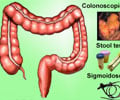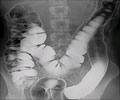A new study examines the occurrence of interval colorectal cancer despite regular colonoscopy and highlights the importance of close follow-up for patients who have a history of advanced adenomas, which are precancerous polyps. Researchers studied the rate of interval colorectal cancer in patients participating in the Polyp Prevention Trial Continued Follow-up Study and found that nine cases of colorectal cancer were diagnosed over 7,626 person-years of observation for an incidence rate of 1.2 per 1,000 person-years of observation. Of patients in whom colorectal cancer developed, 78 percent had a history of advanced adenoma.
The majority of the cancers detected were early stage (78 percent were stage I or II) and therefore highly curable. The study appears in the January issue of GIE: Gastrointestinal Endoscopy, the monthly peer-reviewed scientific journal of the American Society for Gastrointestinal Endoscopy.Colonoscopy is recommended as the primary screening method for colorectal cancer and is the final common pathway for all other recommended screening tests. It is considered the "gold standard" for colorectal cancer screening because of the ability to diagnose and remove polyps (growths) before they become cancer. A recent study by leading cancer groups reported that from 1975 to 2000, colorectal cancer incidence rates dropped 22 percent and death rates dropped 26 percent. The report stated that "screening appears to have had a considerable impact on reducing CRC incidence and mortality."After initial colonoscopy, patients with adenomas (benign, precancerous polyps), are followed by surveillance colonoscopy to identify and remove subsequent adenomas before they progress to colorectal cancer.
"Despite regular colonoscopy, interval colorectal cancer may occur. We set out to examine the rate at which these interval cancers appear," said study lead author Robert E. Schoen, MD, MPH, Professor of Medicine and Epidemiology at the University of Pittsburgh, Pennsylvania. "Our results showed that nine patients developed colorectal cancer for a rate of 1.2 cases per 1,000 person-years of observation despite undergoing a mean of more than three colonoscopies. The majority of patients in our study in whom colorectal cancer developed had a previous advanced adenoma. Our results confirm the need for continued colonoscopy surveillance in at-risk patients because of the ongoing risk of colorectal cancer, especially among those with a history of advanced adenoma. And, we must be sure that a polyp, especially if it is an advanced adenoma, is completely removed, since cancer may develop subsequently at that site if residual tissue remains."
Patients and MethodsThe Polyp Prevention Trial (PPT) was a four-year multicenter, randomized, controlled trial designed to examine the effect of a low-fat, high-fiber, high-fruit and vegetable diet on the recurrence of colorectal adenomas. During the main phase of the trial, 1,905 patients completed the study and underwent an average of 3.1 colonoscopies. After the completion of the trial, patients were given the opportunity to enroll in the observational PPT Continued Follow-up Study (PPT-CFS) for an additional four years or more. Patients agreed to provide information to researchers via annual health and lifestyle questionnaires that included questions about hospitalization, colonoscopy and cancer diagnoses. Subsequent colonoscopy was performed at the discretion of the clinicians caring for the patients.
The aim of this study was to determine the rate of interval colorectal cancer subsequent to the main phase of the PPT and to characterize and examine the circumstances surrounding the diagnosis of cancer. Because patients had undergone frequent colonoscopy as part of the PPT, researchers wanted to evaluate how frequent colonoscopy examinations, although in a limited time frame, might affect the rate of subsequent colorectal cancer over a more prolonged period. For this study, all patients with colorectal cancer diagnosed after enrollment in the PPT-CFS were considered interval cancers. The incidence rate was calculated based on the number of subsequent colorectal cancer cases and the total number of person-years of observation. Researchers emphasized that this study is not a population-based study of colonoscopy effectiveness in that all patients began with adenomatous polyps.
ResultsOf 1,297 patients, mean age 65.3 years at PPT-CFS study entry, who had colorectal adenomas removed and underwent a mean of 3.3 colonoscopies over a median of 4.3 years of follow-up during the PPT, and who were then followed for an additional mean of 6.2 years during the PPT-CFS, nine cases of colorectal cancer were diagnosed for an incidence rate of 1.2 per 1,000 person-years of observation. Of the new colorectal cancer cases diagnosed during the PPT-CFS, 78 percent of patients had a history of an advanced adenoma, compared to only 43 percent of patients who remained cancer free. Eight out of the nine cancers were located in the proximal colon, where studies have suggested that colonoscopy is less successful in detection. In addition, researchers found that 78 percent of the new colorectal cancer cases diagnosed during the PPT-CFS were diagnosed in men and 44 percent had a family history of colorectal cancer. At diagnosis, the majority of the cancers, 78 percent, were stage I or stage II, a point at which they are highly curable.
Researchers noted some study limitations, including only a small number of cases of colorectal cancer were identified limiting statistical analysis and 68 percent of those originally enrolled in the PPT participated in the PPT-CFS, which could have led to a biased sample. They concluded that despite frequent colonoscopy during the PPT, there was a persistent ongoing risk of cancer in the years after the trial. Patients with a history of advanced adenoma are at increased risk of subsequent cancer and should be followed closely with continued surveillance.
At-Risk PopulationsOne important finding of this study is that patients with a history of advanced adenomas had a higher ongoing risk for subsequent cancer, even above that of subjects with non-advanced adenomas. Follow-up exams for patients with advanced adenomatous polyps are very important, even after a negative follow-up colonoscopy, since the data suggest that the risk of cancer persists.
Quality Colonoscopy ScreeningThis study also highlights the importance of quality colonoscopy screening, since some of the interval cancers appeared to be missed or to have developed at sites where a previous adenoma had been detected. ASGE, as the standard-setting society for endoscopy, has issued quality indicators for colorectal cancer screening that define measures for improving quality in colonoscopy. Experts in gastrointestinal endoscopy should encourage their patients to take their bowel prep as directed before the colonoscopy. Proper bowel prep is important so that the physician can clearly see the colon. In addition, endocopists must be mindful of the importance of not withdrawing too soon during the procedure, allowing enough time to thoroughly examine the colon. According to ASGE quality indicators, average withdrawal time should be six minutes or more.
Source-Eurekalert
SRM















